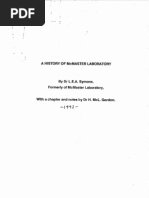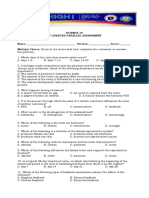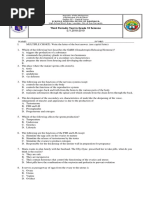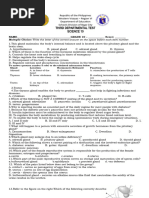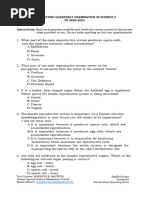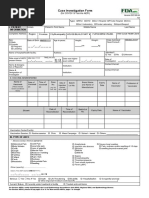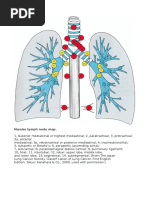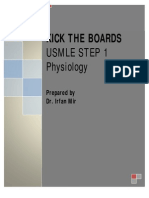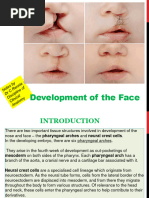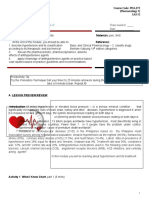Quarterly Examination in Science 10 SY 2022-2023 Instructions: Read Each Question Carefully and Shade The Correct Answer in The
Quarterly Examination in Science 10 SY 2022-2023 Instructions: Read Each Question Carefully and Shade The Correct Answer in The
Uploaded by
Jolmar A RudelaCopyright:
Available Formats
Quarterly Examination in Science 10 SY 2022-2023 Instructions: Read Each Question Carefully and Shade The Correct Answer in The
Quarterly Examination in Science 10 SY 2022-2023 Instructions: Read Each Question Carefully and Shade The Correct Answer in The
Uploaded by
Jolmar A RudelaOriginal Title
Copyright
Available Formats
Share this document
Did you find this document useful?
Is this content inappropriate?
Copyright:
Available Formats
Quarterly Examination in Science 10 SY 2022-2023 Instructions: Read Each Question Carefully and Shade The Correct Answer in The
Quarterly Examination in Science 10 SY 2022-2023 Instructions: Read Each Question Carefully and Shade The Correct Answer in The
Uploaded by
Jolmar A RudelaCopyright:
Available Formats
QUARTERLY EXAMINATION IN SCIENCE 10
SY 2022-2023
Instructions: Read each question carefully and shade the correct answer in the
answer sheet provided to you. Do not write anything on this test
questionnaire.
1. Our body is composed of organ systems that work together to make a complete
and functional organism. What organ system is specialized to produce offspring?
A. Nervous System
B. Digestive System
C. Respiratory System
D. Reproductive System
2. What are the hormones needed in order to produce milk through the sucking of an
infant at the breast of the mother?
A. Prolactin and Oxytocin
B. Estradiol and Estrogen
C. Prolactin and Estradiol
D. Oxytocin and Progesterone
3. Which is the correct sequence of the male reproductive organs when the sperms
move from the testis to the outside of the body?
I. Urethra
II. Epididymis
III. Vas Deferens
IV. Seminal Vesicle
A. I, III, IV, II
B. II, III, IV, I
C. IV, I, II, III
D. III, I, IV, II
4. In which of the following situations does testosterone serve as an aid in gaining
more muscular strength?
A. Jun, who experiences erectile dysfunction, does Testosterone therapy (TRT)
as recommended to him.
B. Miguel, who found out he has a low sperm count, takes testosterone
medications as a solution to it.
C. Andrew, an athlete, takes steroids that contain testosterone or other
similar compounds when he is training.
D. Jude, 55 years old, takes testosterone medications because he believes
that it makes him feel younger and more vigorous.
5. What might happen to the condition of the sperm cells in the absence of the
bulbourethral gland?
A. The sperm cells will die since the bulbourethral gland is responsible for the
secretion of fluid in which sperm can actively swim.
B. The sperm become less active because the bulbourethral gland secretes
slightly alkaline fluid that helps sperm cells swim faster.
C. The sperm cells locomotion becomes more active because the semen
reduces thick mucus that comes from the bulbourethral gland.
D. The sperms will die since the bulbourethral gland secretes a thick and
clear mucus that neutralizes traces of acidic urine in the urethra.
Test Curator: Lady Mae H. Plaza DepEd-Caraga
School: Sayon National High School Sukdanan
Email Address: ladymae.hilario@deped.gov.ph Standardized Quarterly Exam
6. Teacher Jean is discussing the role of hormones in the Reproductive System. Upon
review, a student answers that the pituitary gland secretes a hormone
responsible for the development of female secondary sex characteristics. Is the
student’s answer correct?
A. Yes, the pituitary gland produces progesterone for female.
B. Yes, but the pituitary gland produces progesterone for both males and
females.
C. No, the pituitary gland does not produce progesterone, as it only produces
estrogen.
D. No, the pituitary gland is not the one that produces progesterone for
female, it is the ovary.
7. Hormones control many of the changes in the reproductive system. What is the
term used to describe the monthly changes that take place in a female
reproductive system that discharges blood and other materials from the lining of
the uterus?
A. Amenorrhea
B. Menopausal
C. Menstruation
D. Pregnancy
8. Menstrual cramps are the result of a strong contraction of the uterine wall and
occur before and during menstruation. What could possibly be the cause of these
cramps?
A. abnormal secretion of estrogen
B. absence of secretion of estradiol
C. insufficient secretion of oxytocin
D. excessive secretion of prostaglandins
9. The body maintains its state of balance, or homeostasis, through a control system
activated by many feedback systems. Which of the following statements BEST
describes how these feedback mechanisms are involved in regulating processes
in the female reproductive system?
I. The follicle-stimulating hormone (FSH) stimulates the ovarian follicle,
causing an egg to mature.
II. During the luteal phase of the menstrual cycle, luteinizing hormone (LH)
activates the corpus luteum to secrete estrogen and progesterone.
III. During the follicular phase of the menstrual cycle, estrogen released from
the follicle triggers the release of luteinizing hormone (LH) from the
anterior pituitary gland.
A. I only
B. I and II
C. II and III
D. I, II, and III
10. The nervous system is like a communication network that transmits information
by electrical signals. Which of the following is the basic unit of nervous system?
A. Axon
B. Impulse
C. Neuron
D. Synapse
Test Curator: Lady Mae H. Plaza DepEd-Caraga
School: Sayon National High School Sukdanan
Email Address: ladymae.hilario@deped.gov.ph Standardized Quarterly Exam
11. What will happen to the mature egg if fertilization takes place?
A. The egg will travel back to the ovary through the oviduct.
B. The egg and the blood will both be lost along with the thickened uterine
linings.
C. The egg will attach to the thickened uterine lining for another fertilization
process.
D. Pregnancy will take place, and the egg will attach to the uterus and
continue to grow inside the womb.
12. Andrea was tasked with cleaning their garden at ten o’clock in the morning, when
the heat of the sun strikes her a lot. How do the nervous and endocrine systems
respond to an increase in environmental temperature to achieve homeostasis?
A. Her muscles will contract as a response to the high temperature.
B. Her body will become weak and tired due to too much heat from the sun.
C. Her body will release sweat to lower the temperature of the internal organs
cool her down.
D. Her nervous and endocrine systems will let her sneeze to release the heat
inside her body.
13. Both the nervous system and endocrine system are important in enabling the
body to maintain homeostasis. Homeostasis reaches and maintains a state of
balance by using feedback mechanisms. Which of the following statements
support/s the concept of homeostasis?
I. The levels of hormones within the body are controlled by feedback.
II. The nervous and endocrine systems work together to restore the body to its
normal state.
III. The amount of hormones in our body must be kept at the right level, but
exceeding that level is still considered okay.
A. I only
B. II only
C. I and II
D. I, II, and III
14. The DNA and RNA are made up of nitrogenous bases. What nitrogenous base is
found in RNA but NOT in DNA?
A. Cytosine
B. Guanine
C. Thymine
D. Uracil
15. During DNA replication, which nitrogen bases can fit together to make base
pairs?
A. Adenine and Uracil fit together, and Cytosine and Guanine fit together.
B. Thymine and Uracil fit together, and Guanine and Cytosine fit together.
C. Adenine and Cytosine fit together, and Guanine and Thymine fit together.
D. Adenine and Thymine fit together, and Guanine and Cytosine fit together.
Test Curator: Lady Mae H. Plaza DepEd-Caraga
School: Sayon National High School Sukdanan
Email Address: ladymae.hilario@deped.gov.ph Standardized Quarterly Exam
16. Given the base sequence on one strand of a DNA molecule,
A T T G C C A G T G G T. If transcribed into mRNA, what would be the resulting
strand?
A. U C G T C G G T C T U A
B. U A A U C G G A T U C A
C. U A A C G G U C A C C A
D. U C G U C T U C U A G A
For items 17-18, refer to the Genetic Code Table below.
Figure 1. Genetic Code Table
(Source: https://www.sciencelearn.org.nz/images/2333-the-genetic-code)
17. Which of the following orders of bases shows the correct set of codes resulting in
Threonine?
A. CAT – GUA – CAU
B. TGA – ACU – UGA
C. CAG – CAG – GUC
D. GGT – CCA – GGU
18. Which of the following orders of bases shows the correct sets of codes?
A. CAG - GUC - CAG - Valine
B. GGT - UCU - GGA - Proline
C. TGA - UGU - ACG - Leucine
D. ATG- UAC - AAG - Methionine
19. “DNA and RNA differ in their number of strands, location in cell, and nitrogenous
base pair.” Is this statement true?
A. True. DNA and RNA differ in all those aspects.
B. False. DNA and RNA only differ in their number of strands and location.
C. False. DNA and RNA only differ in their location and nitrogenous base pair.
D. Maybe. There is no enough evidence that proves DNA and RNA differ with
each other.
Test Curator: Lady Mae H. Plaza DepEd-Caraga
School: Sayon National High School Sukdanan
Email Address: ladymae.hilario@deped.gov.ph Standardized Quarterly Exam
20. Mutations are changes in the chromosomes of an organism. Which type of
mutation occurs when base substitution results in the generation of a codon that
specifies a different amino acid?
A. Deletion
B. Frameshift
C. Insertion
D. Missense
21. If there is a way to correct “Cri du chat” disorder at the chromosomal level, which
method would it be?
A. Add another chromosome to chromosome 18.
B. Eliminate the extra chromosome in chromosome 23.
C. Remove the extra genes in the long arm of chromosome 21.
D. Insert the right genes in the deleted part of the short arm of chromosome
5.
22. Which of the following situations or practices should a person avoid to prevent
mutation of the cells specifically on the chromosomes?
I. Drinking plenty of water
II. Too much exposure to radiation
III. Eating charcoal-grilled barbeques
IV. Applying products with lead and mercury to the body
A. IV only
B. I and II
C. I, III and IV
D. II, III and IV
For item 23, refer to the image of a child with a chromosomal mutation below.
Figure 2. Child with Chromosonal Mutation
(Source:https://therapiesforkids.com.au)
23. Considering the characteristics and appearance of an infant. Which
chromosomal mutation is described in Figure 2?
A. Down Syndrome
B. Turner’s Syndrome
C. Edwards Syndrome
D. Klinefelter’s Syndrome
Test Curator: Lady Mae H. Plaza DepEd-Caraga
School: Sayon National High School Sukdanan
Email Address: ladymae.hilario@deped.gov.ph Standardized Quarterly Exam
24. Viruses constantly change through mutation. When a virus has one or more new
mutations, it is called a variant of the original virus. When viruses (such as the
coronavirus that causes COVID-19) have more exposure to the environment,
there is a possibility of new variants being identified. What idea can you
formulate based on this?
A. Generally, mutations are dangerous.
B. There are also mutations in viruses, not just in humans.
C. The spread of viruses and their variants cannot be controlled or stopped.
D. The more the virus is exposed, the more chances there are of it being
mutated.
25. Would a mutation in the DNA of a skin cell be passed on to an organism's
offspring?
A. Yes. Any change to the DNA is passed on to the offspring.
B. No. Only mutations that occur in the sex cells are passed on to the
offspring.
C. Maybe. Sex cells only use half of the body's genetic code. It might get a
copy of a gene that wasn't mutated.
D. Maybe. Without knowing the animal, it would be hard to tell whether the
mutation would be passed on because it differs from one organism to
another.
26. Fossils are examples of evidence that paleontologists use in studying evolution.
They are traces of organisms that lived in the past and were preserved by natural
process or catastrophic events. Where can most of the fossils be found?
A. Black soil
B. Lava flows
C. Granite rock
D. Sedimentary rock
27. How did paleontologists determine the age of fossils?
A. They estimated the age of the fossils according to its weight. The denser
fossils are older, and the less dense fossils are younger.
B. They estimated the age of the fossils based on their current texture. The
rough texture of fossils is older than the fine texture of the fossils.
C. They based the age of fossils according to its remaining size and color. The
bigger and darker color are older than the smaller and lighter color.
D. They make initial estimates of the age through the position in the
sedimentary rocks, and fossils found in the bottom layer are older than
those on the upper layer rocks.
28. If you were a paleontologist, which of the following data should NOT be
considered in analyzing the evolution of life?
A. Fossil records
B. Fossil oxygen content
C. Embryonic development
D. Anatomy and morphology
Test Curator: Lady Mae H. Plaza DepEd-Caraga
School: Sayon National High School Sukdanan
Email Address: ladymae.hilario@deped.gov.ph Standardized Quarterly Exam
For item 29, refer to figure 3 below. The figure displays a cross section of a
portion of the earth’s crust that has overturned. Letters A, B, and C represent
sedimentary rock layers that contain fossils.
Figure 3. Fossils in Sediments
(Source: https://clarkscience8.weebly.com/law-of-superposition--index-fossils.html)
.
29. Based on the figure presented, which of the following statements is correct?
A. Fossil B is older than fossils A and C.
B. Fossils A, B, and C have the same age.
C. Fossil C is younger than fossils A and B.
D. Fossil A is younger than fossils B and C.
30. Which of the following phrases BEST describes the results of natural selection?
A. The natural variation found in all populations
B. The struggle for existence undergone by all living things
C. Unrelated but similar species living in different locations
D. The changes in the inherited characteristics of a population
31. Which of the following statements are TRUE?
I. Examples of analogous structures are the wings of a bird, a bat, and an
insect.
II. Examples of homologous structures are the limbs of humans, cats, whales,
and bats.
III. Analogous structures are structures found in different species that have
similar functions resulting from a common ancestor.
IV. Homologous structures are structures found in different species that have
similar anatomical forms, resulting from natural selection.
A. I and II
B. I and IV
C. I and III
D. II and IV
32. Many biologists believe that the number of differences between the proteins of
different species indicates how long ago the species diverged from common
ancestors. Why do these biologists believe that humans, chimpanzees, and
gorillas diverged from a common ancestor only a few million years ago?
A. Fewer differences would mean a more recent common ancestor because
there has been less time to accumulate mutations/variation.
B. Fewer differences would mean a less recent common ancestor because
there has been less time to accumulate mutations/variation.
C. Fewer differences would mean a more recent common ancestor because
there has been more time to accumulate mutations/variation.
D. Fewer differences would mean a less recent common ancestor because
there has been more time to accumulate mutations/variation.
Test Curator: Lady Mae H. Plaza DepEd-Caraga
School: Sayon National High School Sukdanan
Email Address: ladymae.hilario@deped.gov.ph Standardized Quarterly Exam
33. An evolutionist who had different views about the theory of use and disuse
believed that giraffe species originally had a varying neck that could feed on taller
trees. Giraffes with short necks were eliminated due to a lack of accessible food
supplies. Who was this evolutionist?
A. Russel Wallace
B. Charles Darwin
C. Carolus Linnaeus
D. Jean Baptiste de Lamarck
34. Which is a major concept included in Lamarck’s theory of evolution?
A. Artificial selection is the basis for evolution.
B. Population size decreases the rate of evolution.
C. Change is the result of the survival of the fittest.
D. Body structure can change according to the actions of the organism.
For item 35, refer to Figure 4, which shows the pair of organisms with
homologous and/or analogous structures.
Figure 4. Homologous and Analogous Structures
(Source: https://brainly.ph/question/13798158)
35. Based on the figure, which of the following options represent analogous
structures?
A. A and D
B. B and C
C. A and C
D. C and D
36. Adaptation is the ability of an organism to adjust to and thrive in a given
environment. Which of the following conditions DOES NOT show the process of
adaptation?
A. a child learning to walk on his own
B. the finches in Galapagos with different beaks
C. certain groups of birds eating different kinds of food
D. dying out of dinosaurs during the Cretaceous period
37. Considering the proposed theory of Charles Darwin, which of the following
statements contradicts his idea about the theory of natural selection?
A. Organisms struggle for existence.
B. Organisms have survival of the fittest and eliminate the unfit.
C. Organisms learned to adapt to their environment in order to reproduce.
D. Organisms’ organs in use will develop and organs not in use will
disappear.
Test Curator: Lady Mae H. Plaza DepEd-Caraga
School: Sayon National High School Sukdanan
Email Address: ladymae.hilario@deped.gov.ph Standardized Quarterly Exam
38. A biologist is studying a natural population of mice and observes that in one area
the proportion of darker-colored mice is greater than the proportion of lighter
colored mice. In another area, the opposite is true. He finds that only the area
with more dark mice has predators. Therefore, you hypothesize that darker mice
are favored in areas with predators, perhaps because they are more difficult to If
your hypothesis is true, what would you expect to happen in the few generations
after predators are introduced to an area with a population of mice that
previously did not have predators?
A. The proportion of darker-colored mice will increase.
B. The proportion of darker-colored mice will decrease.
C. The proportion of darker-colored mice will not change.
D. The predators will evolve to be able to better see the darker mice.
39. Organisms are part of it and may be economically and ecologically valuable. Their
products are sources of food, medicine, clothing, shelter, and energy. These
organisms are also important in maintaining balance in the ecosystem, as they
are performing their specific roles. What is the term that describes the variation
of living things in a specific area?
A. Biodiversity
B. Ecosystem
C. Habitat
D. Population
40. Your friend Arian is fond of visiting a place where she can relax, meditate, and
enjoy the beauty of nature. Which classification of value of biodiversity describes
Arian’s preferred place?
A. Aesthetic Value
B. Direct Economic Value
C. Social Economic Value
D. Indirect Economic Value
41. Some of the causes of deforestation are forest fires, kaingin farming, human
settlements, natural calamities, indiscriminate logging, and overpopulation.
Which of the following ways is NOT a solution to solve these environmental
problems?
A. Consume more water and electricity.
B. Support environment-friendly practices.
C. Replace disposal items with reusable items.
D. Recycle the waste to conserve natural resources.
42. Jade tried to breed carabaos in a huge and isolated cabin. After a few generations,
he observed that carabaos were getting aggressive toward each other. The young
are less healthy, and more calves die. What do you think will happen to the
population of carabaos?
A. The population will increase.
B. The population will decrease.
C. The population is not affected.
D. The population will remain the same.
43. The number of rats in the rice field is continuously growing at an exponential rate.
Which of the following statements supports the exponential rate of the rats?
A. Most of the rats carry contagious diseases.
B. Many female rats developed numerous babies.
C. Most of the male rats are fighting, which causes them to die.
D. The rice fields have many predators, such as snakes and large birds.
Test Curator: Lady Mae H. Plaza DepEd-Caraga
School: Sayon National High School Sukdanan
Email Address: ladymae.hilario@deped.gov.ph Standardized Quarterly Exam
44. The bright-colored feathers could be an adaptation for a bird living in a temperate
forest. Is the statement true?
A. Yes, it could make the bird attract mates.
B. Yes, it could make the bird a worse hunter.
C. No, it could make it simpler for the bird to hide.
D. Yes. It could make it harder for the bird to reproduce.
45. As a population approaches its carrying capacity, and individual organisms leave
and go to a new area where they can find enough resources for survival and
reproduction, this will cause a decrease in the number of organisms in a
population. What do you call the movement of organisms into a given area from
another area?
A. migration
B. emigration
C. population shift
D. carrying capacity
46. Cocolisap infestation outbreak has been declared in some parts of the Philippines.
The cocolisap attacks the coconut tree by eating the leaves, fruits, and flowers
until the trunk is left. Which of the following factors limits the population of
coconut trees?
A. Predation
B. Emigration
C. Diseases and parasites
D. Competition for resources
47. Which of the following situations is an example of predation as a limiting factor of
population growth?
A. The population of birds decreases because of deforestation.
B. Increasing numbers of frogs in the pond cause a decrease in insects.
C. The oil spill in Manila Bay harmed the lives of many aquatic organisms in
the vicinity.
D. Three students from section Daisy were transferred to section Tulips
because the classroom capacity is only good for 30 students.
48. Our country has a high degree of endemism, meaning a large number of native
species of flora and fauna are found only in tropical communities. How should
tropical communities be used to conserve their resources?
A. Get only a minor forest product to avoid deterioration.
B. Cut the trees into logs and make timber to earn money.
C. Convert it into an industrial area for business purposes.
D. Advertise it as a camping site to encourage more campers.
Test Curator: Lady Mae H. Plaza DepEd-Caraga
School: Sayon National High School Sukdanan
Email Address: ladymae.hilario@deped.gov.ph Standardized Quarterly Exam
49. Two populations of a species of squirrel are geographically isolated from each
other. Although they have the same population density, one population is
significantly larger in number than the other. A new bacterial disease, which is
easily spread and extremely virulent, affects both populations at the same time.
Which of the following is the best prediction of how the new disease will affect the
two populations?
A. The two populations will be equally affected because the ability to trigger
the immune response is randomly distributed among all squirrels of that
species.
B. The smaller population will be more affected than the larger population
because the smaller population has less genetic variation than the larger
population.
C. The smaller population will be less affected than the larger population
because the smaller population exhibits more genetic drift than the larger
population does.
D. The larger population will be less affected by the disease than the smaller
population because the mutation rate of the larger population is higher
than the mutation rate of the smaller population.
For item 50, refer to Figure 5, which shows the graph of the number of rabbits in
its carrying capacity.
Figure 5. Logistic Exponential Growth
(Source: https://www.proprofs.com/quiz-school/story.php?title=32-logistic-exponential-growth)
50. Which of the following statements is TRUE about the graph?
A. The rabbit’s population is increasing from August 1st to September 1st.
B. The carrying capacity of the rabbit is 65, and it is constant from the first
month up to the last month.
C. The carrying capacity of the rabbit is 65, and there is a slow phase of
population growth from June 1st to August 1st.
D. The rabbit’s carrying capacity is 65. The rabbit’s population stops growing,
indicating that the area can only accommodate and support 65 rabbits.
Test Curator: Lady Mae H. Plaza DepEd-Caraga
School: Sayon National High School Sukdanan
Email Address: ladymae.hilario@deped.gov.ph Standardized Quarterly Exam
You might also like
- Attack of The Moral Fuzzies by Nancy BeverlyDocument11 pagesAttack of The Moral Fuzzies by Nancy BeverlyTyler ThompsonNo ratings yet
- Full Serrapeptase Ebook PDFDocument358 pagesFull Serrapeptase Ebook PDFMarc Abba100% (1)
- Science 10 Summative Test 1 Quarter3 With AnswerDocument3 pagesScience 10 Summative Test 1 Quarter3 With AnswerRowena Nim100% (10)
- A History of McMaster LaboratoryDocument150 pagesA History of McMaster LaboratoryeboliNo ratings yet
- O Level Biology Practice Questions And Answers: Heredity And Molecular GeneticsFrom EverandO Level Biology Practice Questions And Answers: Heredity And Molecular GeneticsNo ratings yet
- S10 - Midterm AssessmentDocument7 pagesS10 - Midterm AssessmentRutchie LasqueNo ratings yet
- PERIODICAL 3RD QUARTER-EDITTEDDocument6 pagesPERIODICAL 3RD QUARTER-EDITTEDSimone EstipularNo ratings yet
- Grade 10 Science Sum. TestfinalDocument6 pagesGrade 10 Science Sum. TestfinalHAIDEENo ratings yet
- TQ q3 Science 10 Aster Madalla - Asterio MadallaDocument8 pagesTQ q3 Science 10 Aster Madalla - Asterio MadallaKhim YabesNo ratings yet
- S10 - Q3 - Answer Key 2Document7 pagesS10 - Q3 - Answer Key 2rm9qxhyrh6No ratings yet
- Multiple ChoiceDocument6 pagesMultiple ChoiceBenmar L. OrterasNo ratings yet
- S10 - Q3 - Answer Key 1Document6 pagesS10 - Q3 - Answer Key 1rm9qxhyrh6No ratings yet
- Science10Q3Exam TestBankDocument9 pagesScience10Q3Exam TestBankCrisante Maruquin100% (1)
- 3rd Quarter ReviewerDocument2 pages3rd Quarter ReviewerRaiza JaneNo ratings yet
- Directions: Choose The Letter of The Correct Answer. Write Your Answers On Your Answer SheetDocument6 pagesDirections: Choose The Letter of The Correct Answer. Write Your Answers On Your Answer SheetVianca Andyella BendoNo ratings yet
- Q3 SCIENCE 10 Pretest 2023 2024Document5 pagesQ3 SCIENCE 10 Pretest 2023 2024Rose-AnnMirambilNo ratings yet
- Validation Test No. 1 in Grade 10 Science Quarter 3 Week 1-4Document2 pagesValidation Test No. 1 in Grade 10 Science Quarter 3 Week 1-4orlan sisonNo ratings yet
- TQ Science10 Q3 ST1Document3 pagesTQ Science10 Q3 ST1mae cudalNo ratings yet
- Department of Education: Summative Test in Science 10Document3 pagesDepartment of Education: Summative Test in Science 10Christine RamosNo ratings yet
- Third Periodical Test - Science 10 ANS KEYDocument4 pagesThird Periodical Test - Science 10 ANS KEYMerlita CahuloganNo ratings yet
- 3RD Periodical ExamDocument3 pages3RD Periodical ExamAbegail FajardoNo ratings yet
- Q3 - SCIENCE 10 Parallel AssessmentDocument4 pagesQ3 - SCIENCE 10 Parallel AssessmentMel VilNo ratings yet
- S5 - Q2 - Answer KeyDocument11 pagesS5 - Q2 - Answer KeyJason PlazaNo ratings yet
- 3RD-PT-SCIENCE-10Document4 pages3RD-PT-SCIENCE-10Danah GaaNo ratings yet
- S5 - Q2 - Answer Key 1Document4 pagesS5 - Q2 - Answer Key 1Jason PlazaNo ratings yet
- Third Periodic Test in Grade 10 Science: Schools Division Office of PampangaDocument6 pagesThird Periodic Test in Grade 10 Science: Schools Division Office of PampangaKimberly NgNo ratings yet
- ErasuresDocument5 pagesErasuresAple RigorNo ratings yet
- Summative Assessment Q3Document6 pagesSummative Assessment Q3Myth LiliNo ratings yet
- Q3-Pretest Science 10Document4 pagesQ3-Pretest Science 10jennifer.culala001No ratings yet
- Third Departmental Test G10Document4 pagesThird Departmental Test G10joy grace jaraNo ratings yet
- IKATLONG PANAHUNANG PAGSUSULIT Science10-2022-2023Document4 pagesIKATLONG PANAHUNANG PAGSUSULIT Science10-2022-2023MARITES DURANGONo ratings yet
- 3rd PT Grade 10 2019-2020Document3 pages3rd PT Grade 10 2019-2020Phoebe Sudweste QuitanegNo ratings yet
- Q2_S3_TOS (Binisaya)Document10 pagesQ2_S3_TOS (Binisaya)viema eviotaNo ratings yet
- ST2 3rdDocument2 pagesST2 3rdMaida Micosa100% (1)
- UntitledDocument45 pagesUntitlednicolasandrey borjaNo ratings yet
- 3 Unit TestDocument56 pages3 Unit Testkerby manaoisNo ratings yet
- S5_Q2_Answer KeyDocument13 pagesS5_Q2_Answer KeyLADY DANIELA VILLARINNo ratings yet
- TQ Science10Document10 pagesTQ Science10ofelia guinitaranNo ratings yet
- PTQ3Document7 pagesPTQ3CINDYNo ratings yet
- Grade 10 Quarter 3 Lym ADocument4 pagesGrade 10 Quarter 3 Lym ALymberth BenallaNo ratings yet
- Biocomp Exam 2010Document12 pagesBiocomp Exam 2010e100% (1)
- 3rd Quarterly Exam 2024Document5 pages3rd Quarterly Exam 2024Maylen JuntaNo ratings yet
- Grade 10 Quarter 3 Lym BDocument4 pagesGrade 10 Quarter 3 Lym BLymberth Benalla100% (1)
- 3rd Quarter Exam Science 10Document5 pages3rd Quarter Exam Science 10ROMELYN GRACE BORBENo ratings yet
- C10 and C12 Sample QuestionsDocument7 pagesC10 and C12 Sample QuestionsNicole NicoleNo ratings yet
- 3rd Quarter Exam SY 2023-2024Document12 pages3rd Quarter Exam SY 2023-2024abegailailene.saribaNo ratings yet
- Science 10- Quarter 3 TQDocument5 pagesScience 10- Quarter 3 TQJetjet RicardelNo ratings yet
- Third Quarter Exam in Science 10Document3 pagesThird Quarter Exam in Science 10Marife GuadalupeNo ratings yet
- Hormonal Control (Quistions)Document6 pagesHormonal Control (Quistions)abdulalemalnsefNo ratings yet
- Third Summative Test 2023 2024 Grade 10Document5 pagesThird Summative Test 2023 2024 Grade 10janilmago8No ratings yet
- Biocomp Exam 2010Document12 pagesBiocomp Exam 2010SciOlympiad2345No ratings yet
- Sci10 Q3 Module1Document23 pagesSci10 Q3 Module1Jinky AydallaNo ratings yet
- RectoDocument2 pagesRectoDiane Tayab MorenoNo ratings yet
- Solo Items FinalDocument7 pagesSolo Items Finalanochejoan82No ratings yet
- 3rd Long TestDocument6 pages3rd Long TestDaiseree SalvadorNo ratings yet
- PTSCIDocument4 pagesPTSCIDaiseree SalvadorNo ratings yet
- 1Document24 pages1Venice Laureign AgarpaoNo ratings yet
- Science 10 Summative 2Document3 pagesScience 10 Summative 2Adrian Perez TastarNo ratings yet
- General Instruction: Please Avoid Erasures. Any Form of Erasures Are Not CountedDocument5 pagesGeneral Instruction: Please Avoid Erasures. Any Form of Erasures Are Not CountedCherrina AguilaNo ratings yet
- Cansuje National High School: Quarter 3 Summative Test No. 1 in Science 10Document3 pagesCansuje National High School: Quarter 3 Summative Test No. 1 in Science 10Jannet FuentesNo ratings yet
- 3rd Quarter Exam Science 10Document3 pages3rd Quarter Exam Science 10Rizel Shaira Hope TanamanNo ratings yet
- Q2 Science 7 MIDTERMDocument4 pagesQ2 Science 7 MIDTERMDonna Joy Abrajano GonzalesNo ratings yet
- O Level Biology Practice Questions And Answers: Reproduction In HumansFrom EverandO Level Biology Practice Questions And Answers: Reproduction In HumansRating: 2 out of 5 stars2/5 (2)
- The Treatment of Stage IV Cancer1Document9 pagesThe Treatment of Stage IV Cancer1Anthony SullivanNo ratings yet
- Master List Beneficiaries For School-Based Feeding Program (SBFP)Document9 pagesMaster List Beneficiaries For School-Based Feeding Program (SBFP)Hercules Verdeflor Valenzuela100% (1)
- MCQ Omfs 23-24Document6 pagesMCQ Omfs 23-24Sayan MondalNo ratings yet
- Case Investigation Form: Name of Disease Reporting Unit: I. Patient InformationDocument4 pagesCase Investigation Form: Name of Disease Reporting Unit: I. Patient Informationjuwan decastroNo ratings yet
- Chapter 2 (Cell Organisation)Document3 pagesChapter 2 (Cell Organisation)Danial AsyraafNo ratings yet
- Hydrated Lime Msds 05 12Document6 pagesHydrated Lime Msds 05 12kahuna30No ratings yet
- Synonyms Egg Drop, Egg Drop Syndrome 76, EDS-76Document17 pagesSynonyms Egg Drop, Egg Drop Syndrome 76, EDS-76rahma tamren100% (1)
- Report ViewerDocument1 pageReport Viewervoldemort killerNo ratings yet
- Cadmium: Stephen J. Traub and Robert S. HoffmanDocument4 pagesCadmium: Stephen J. Traub and Robert S. HoffmanRoppeNo ratings yet
- AML ALL CML CML Kronik CML Aksel CML Krisis Blast CLLDocument1 pageAML ALL CML CML Kronik CML Aksel CML Krisis Blast CLLali hosenNo ratings yet
- Ganglioni MediastinaliDocument1 pageGanglioni Mediastinaliburaga madalinaNo ratings yet
- Irfan Mir Physiology Usmle Step 1Document37 pagesIrfan Mir Physiology Usmle Step 1sammieahemdNo ratings yet
- NCM 33 Framework For Maternal and Child Health Nursing: ST ST RD ND TH TH RD TH TH THDocument5 pagesNCM 33 Framework For Maternal and Child Health Nursing: ST ST RD ND TH TH RD TH TH THSherika Mariz Moreno GuarinNo ratings yet
- Consolatrix College of Toledo City, IncDocument5 pagesConsolatrix College of Toledo City, IncNicole NavarroNo ratings yet
- Antibiotic Cross-Sensitivity ChartDocument1 pageAntibiotic Cross-Sensitivity ChartChing JuNo ratings yet
- Genetic Engineering Thesis StatementDocument5 pagesGenetic Engineering Thesis Statementjillturnercincinnati100% (2)
- A_Review_on_Plant_Disease_Detection_Using_Hyperspectral_ImagingDocument27 pagesA_Review_on_Plant_Disease_Detection_Using_Hyperspectral_Imaginguppho936No ratings yet
- Development of FaceDocument34 pagesDevelopment of FacealkalicharanNo ratings yet
- Subjective Assessment of MSK Lecture 2Document3 pagesSubjective Assessment of MSK Lecture 2Walter WanNo ratings yet
- PCOL 2 FLModule #2 (AntiHTNsive Agents) PDFDocument10 pagesPCOL 2 FLModule #2 (AntiHTNsive Agents) PDFAngel de la VictoriaNo ratings yet
- Consensus On The Rational Use of Antithrombotics in Veterinary Critical Care (CURATIVE) Domain 6Document61 pagesConsensus On The Rational Use of Antithrombotics in Veterinary Critical Care (CURATIVE) Domain 6BiancaNo ratings yet
- Advanced Practice Test 2Document7 pagesAdvanced Practice Test 2phươngNo ratings yet
- 500 Quotes From Heaven - Life-Changing Quotes That Reveal The Wisdom & Power of Near-Death ExperiencesDocument243 pages500 Quotes From Heaven - Life-Changing Quotes That Reveal The Wisdom & Power of Near-Death Experiencesjan75% (4)
- A Case of Cerebral PalsyDocument26 pagesA Case of Cerebral PalsyAnas MohiuddinNo ratings yet
- Army Life - Your Guide To The Medical ServicesDocument15 pagesArmy Life - Your Guide To The Medical Servicesdemarchi2330No ratings yet
- 1 General Pharmacology MCQSDocument7 pages1 General Pharmacology MCQSMaaz Nasim83% (6)
- Drug StudyDocument4 pagesDrug StudyIrveen Joy Ramirez100% (1)



